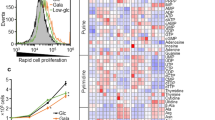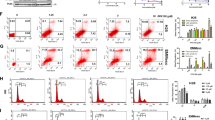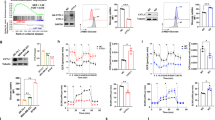Abstract
Most cancer cells exhibit increased glycolysis for generation of their energy supply. This specificity could be used to preferentially kill these cells. In this study, we identified the signaling pathway initiated by glycolysis inhibition that results in sensitization to death receptor (DR)-induced apoptosis. We showed, in several human cancer cell lines (such as Jurkat, HeLa, U937), that glucose removal or the use of nonmetabolizable form of glucose (2-deoxyglucose) dramatically enhances apoptosis induced by Fas or by tumor necrosis factor-related apoptosis-inducing ligand. This sensitization is controlled through the adenosine monophosphate (AMP)-activated protein kinase (AMPK), which is the central energy-sensing system of the cell. We established the fact that AMPK is activated upon glycolysis block resulting in mammalian target of rapamycin (mTOR) inhibition leading to Mcl-1 decrease, but no other Bcl-2 anti-apoptotic members. Interestingly, we determined that, upon glycolysis inhibition, the AMPK–mTOR pathway controlled Mcl-1 levels neither through transcriptional nor through posttranslational mechanism but rather by controlling its translation. Therefore, our results show a novel mechanism for the sensitization to DR-induced apoptosis linking glucose metabolism to Mcl-1 downexpression. In addition, this study provides a rationale for the combined use of DR ligands with AMPK activators or mTOR inhibitors in the treatment of human cancers.
This is a preview of subscription content, access via your institution
Access options
Subscribe to this journal
Receive 50 print issues and online access
$259.00 per year
only $5.18 per issue
Buy this article
- Purchase on Springer Link
- Instant access to full article PDF
Prices may be subject to local taxes which are calculated during checkout








Similar content being viewed by others
References
Alves NL, Derks IA, Berk E, Spijker R, van Lier RA, Eldering E . (2006). The Noxa/Mcl-1 axis regulates susceptibility to apoptosis under glucose limitation in dividing T cells. Immunity 24: 703–716.
Amaravadi R, Thompson CB . (2005). The survival kinases Akt and Pim as potential pharmacological targets. J Clin Invest 115: 2618–2624.
Chi MM, Pingsterhaus J, Carayannopoulos M, Moley KH . (2000). Decreased glucose transporter expression triggers BAX-dependent apoptosis in the murine blastocyst. J Biol Chem 275: 40252–40257.
Chipuk JE, Bouchier-Hayes L, Green DR . (2006). Mitochondrial outer membrane permeabilization during apoptosis: the innocent bystander scenario. Cell Death Differ 13: 1396–1402.
Corradetti MN, Guan KL . (2006). Upstream of the mammalian target of rapamycin: do all roads pass through mTOR? Oncogene 25: 6347–6360.
Detterbeck FC, Vansteenkiste JF, Morris DE, Dooms CA, Khandani AH, Socinski MA . (2004). Seeking a home for a PET, part 3: emerging applications of positron emission tomography imaging in the management of patients with lung cancer. Chest 126: 1656–1666.
Eguchi Y, Shimizu S, Tsujimoto Y . (1997). Intracellular ATP levels determine cell death fate by apoptosis or necrosis. Cancer Res 57: 1835–1840.
Evans JM, Donnelly LA, Emslie-Smith AM, Alessi DR, Morris AD . (2005). Metformin and reduced risk of cancer in diabetic patients. BMJ 330: 1304–1305.
Ferrari D, Stepczynska A, Los M, Wesselborg S, Schulze-Osthoff K . (1998). Differential regulation and ATP requirement for caspase-8 and caspase-3 activation during CD95- and anticancer drug-induced apoptosis. J Exp Med 188: 979–984.
Gambhir SS . (2002). Molecular imaging of cancer with positron emission tomography. Nat Rev Cancer 2: 683–693.
Guertin DA, Sabatini DM . (2007). Defining the role of mTOR in cancer. Cancer Cell 12: 9–22.
Halicka HD, Ardelt B, Li X, Melamed MM, Darzynkiewicz Z . (1995). 2-Deoxy-D-glucose enhances sensitivity of human histiocytic lymphoma U937 cells to apoptosis induced by tumor necrosis factor. Cancer Res 55: 444–449.
Han J, Goldstein LA, Gastman BR, Rabinowich H . (2006). Interrelated roles for Mcl-1 and BIM in regulation of TRAIL-mediated mitochondrial apoptosis. J Biol Chem 281: 10153–10163.
Herrant M, Jacquel A, Marchetti S, Belhacene N, Colosetti P, Luciano F et al. (2004). Cleavage of Mcl-1 by caspases impaired its ability to counteract Bim-induced apoptosis. Oncogene 23: 7863–7873.
Inoki K, Li Y, Xu T, Guan KL . (2003). Rheb GTPase is a direct target of TSC2 GAP activity and regulates mTOR signaling. Genes Dev 17: 1829–1834.
Koschny R, Walczak H, Ganten TM . (2007). The promise of TRAIL--potential and risks of a novel anticancer therapy. J Mol Med 85: 923–935.
Kruyt FA . (2008). TRAIL and cancer therapy. Cancer Lett 263: 14–25.
Lavallard VJ, Pradelli LA, Paul A, Beneteau M, Jacquel A, Auberger P et al. (2009). Modulation of caspase-independent cell death leads to resensitization of imatinib mesylate-resistant cells. Cancer Res 69: 3013–3020.
Leist M, Single B, Castoldi AF, Kuhnle S, Nicotera P . (1997). Intracellular adenosine triphosphate (ATP) concentration: a switch in the decision between apoptosis and necrosis. J Exp Med 185: 1481–1486.
Long YC, Zierath JR . (2006). AMP-activated protein kinase signaling in metabolic regulation. J Clin Invest 116: 1776–1783.
Luciano F, Ricci JE, Herrant M, Bertolotto C, Mari B, Cousin JL et al. (2002). T and B leukemic cell lines exhibit different requirements for cell death: correlation between caspase activation, DFF40/DFF45 expression, DNA fragmentation and apoptosis in T cell lines but not in Burkitt's lymphoma. Leukemia 16: 700–707.
Marchetti S, Gamas P, Belhacene N, Grosso S, Pradelli LA, Colosetti P et al. (2009). The caspase-cleaved form of LYN mediates a psoriasis-like inflammatory syndrome in mice. EMBO J 28: 2449–2460.
Maurer U, Charvet C, Wagman AS, Dejardin E, Green DR . (2006). Glycogen synthase kinase-3 regulates mitochondrial outer membrane permeabilization and apoptosis by destabilization of MCL-1. Mol Cell 21: 749–760.
Mills JR, Hippo Y, Robert F, Chen SM, Malina A, Lin CJ et al. (2008). mTORC1 promotes survival through translational control of Mcl-1. Proc Natl Acad Sci USA 105: 10853–10858.
Mott JL, Kobayashi S, Bronk SF, Gores GJ . (2007). mir-29 regulates Mcl-1 protein expression and apoptosis. Oncogene 26: 6133–6140.
Munoz-Pinedo C, Ruiz-Ruiz C, Ruiz de Almodovar C, Palacios C, Lopez-Rivas A . (2003). Inhibition of glucose metabolism sensitizes tumor cells to death receptor-triggered apoptosis through enhancement of death-inducing signaling complex formation and apical procaspase-8 processing. J Biol Chem 278: 12759–12768.
Nam SY, Amoscato AA, Lee YJ . (2002). Low glucose-enhanced TRAIL cytotoxicity is mediated through the ceramide-Akt-FLIP pathway. Oncogene 21: 337–346.
Nencioni A, Hua F, Dillon CP, Yokoo R, Scheiermann C, Cardone MH et al. (2005). Evidence for a protective role of Mcl-1 in proteasome inhibitor-induced apoptosis. Blood 105: 3255–3262.
Scaffidi C, Schmitz I, Zha J, Korsmeyer SJ, Krammer PH, Peter ME . (1999). Differential modulation of apoptosis sensitivity in CD95 type I and type II cells. J Biol Chem 274: 22532–22538.
Shima H, Pende M, Chen Y, Fumagalli S, Thomas G, Kozma SC . (1998). Disruption of the p70(s6k)/p85(s6k) gene reveals a small mouse phenotype and a new functional S6 kinase. EMBO J 17: 6649–6659.
Takeda K, Stagg J, Yagita H, Okumura K, Smyth MJ . (2007). Targeting death-inducing receptors in cancer therapy. Oncogene 26: 3745–3757.
Vander Heiden MG, Plas DR, Rathmell JC, Fox CJ, Harris MH, Thompson CB . (2001). Growth factors can influence cell growth and survival through effects on glucose metabolism. Mol Cell Biol 21: 5899–5912.
Volland S, Amtmann E, Sauer G . (1992). Glucose depletion enhances the anti-tumor effect of TNF. Int J Cancer 52: 384–390.
Wei G, Twomey D, Lamb J, Schlis K, Agarwal J, Stam RW et al. (2006). Gene expression-based chemical genomics identifies rapamycin as a modulator of MCL1 and glucocorticoid resistance. Cancer Cell 10: 331–342.
Wendel HG, De Stanchina E, Fridman JS, Malina A, Ray S, Kogan S et al. (2004). Survival signalling by Akt and eIF4E in oncogenesis and cancer therapy. Nature 428: 332–337.
Wendel HG, Silva RL, Malina A, Mills JR, Zhu H, Ueda T et al. (2007). Dissecting eIF4E action in tumorigenesis. Genes Dev 21: 3232–3237.
Zhao Y, Altman BJ, Coloff JL, Herman CE, Jacobs SR, Wieman HL et al. (2007). Glycogen synthase kinase 3alpha and 3beta mediate a glucose-sensitive antiapoptotic signaling pathway to stabilize Mcl-1. Mol Cell Biol 27: 4328–4339.
Zhong Q, Gao W, Du F, Wang X . (2005). Mule/ARF-BP1, a BH3-only E3 ubiquitin ligase, catalyzes the polyubiquitination of Mcl-1 and regulates apoptosis. Cell 121: 1085–1095.
Acknowledgements
We thank Magali Herrant for her input, Audrey Paul and Céline Gracia for their technical assistance, Issam Ben Sahra, Vanessa Lavallard and Drs Anne-Odile Hueber, Frederic Bost, Stephane Rocchi and Marcel Deckert for providing tools and advises, Dr Ulrich Maurer for providing GSK3 inhibitor and Dr DR Green for Bcl-2 overexpressing Jurkat cells. This study was supported by the Association pour la Recherche sur le Cancer and by l'Agence Nationale de la Recherche (ref ANR-09-JCJC-0003-01). LAP and MAJ received a fellowship from the Conseil régional Provence-Alpes-Cote-d'Azur. MB is supported by a fellowship from La Fondation de France, CM-P is supported by the Fondo de Investigaciones Sanitarias of Spain and J-ER is a recipient of a contrat d'interface INSERM-CHU de Nice.
Author information
Authors and Affiliations
Corresponding author
Additional information
Supplementary Information accompanies the paper on the Oncogene website (http://www.nature.com/onc)
Rights and permissions
About this article
Cite this article
Pradelli, L., Bénéteau, M., Chauvin, C. et al. Glycolysis inhibition sensitizes tumor cells to death receptors-induced apoptosis by AMP kinase activation leading to Mcl-1 block in translation. Oncogene 29, 1641–1652 (2010). https://doi.org/10.1038/onc.2009.448
Received:
Revised:
Accepted:
Published:
Issue Date:
DOI: https://doi.org/10.1038/onc.2009.448
Keywords
This article is cited by
-
BCL-2 protein family: attractive targets for cancer therapy
Apoptosis (2023)
-
By reducing global mRNA translation in several ways, 2-deoxyglucose lowers MCL-1 protein and sensitizes hemopoietic tumor cells to BH3 mimetic ABT737
Cell Death & Differentiation (2019)
-
RETRACTED ARTICLE: Hispidulin induces ER stress-mediated apoptosis in human hepatocellular carcinoma cells in vitro and in vivo by activating AMPK signaling pathway
Acta Pharmacologica Sinica (2019)
-
Mannose impairs tumour growth and enhances chemotherapy
Nature (2018)
-
Macrophages confer survival signals via CCR1-dependent translational MCL-1 induction in chronic lymphocytic leukemia
Oncogene (2017)



